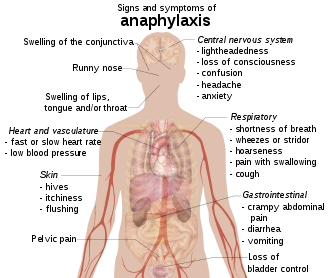Which of the following are clinical manifestations of anaphylaxis? select all that apply
Hypertension
Angioedema
Petechiae
Bronchospasm
Correct Answer : B,D
A. Hypertension: Anaphylaxis often leads to a rapid drop in blood pressure (hypotension) rather than hypertension. Hypotension is a more common symptom because of the severe vasodilation that occurs during anaphylactic reactions.
B. Angioedema: Yes, angioedema is a common clinical manifestation of anaphylaxis. Angioedema involves swelling of the deeper layers of the skin, often around the eyes and lips. It can also affect the throat, which can be life-threatening due to airway obstruction.
C. Petechiae: Petechiae are small red or purple spots that appear on the skin and are caused by bleeding into the skin's tissues. They are not a typical manifestation of anaphylaxis.
D. Bronchospasm: Yes, bronchospasm is a hallmark clinical manifestation of anaphylaxis. It involves the sudden constriction of the airways, leading to difficulty in breathing and wheezing.

Nursing Test Bank
Naxlex Comprehensive Predictor Exams
Related Questions
Correct Answer is C
Explanation
A. Delayed hypersensitivity reaction: This type of hypersensitivity reaction, also known as Type IV hypersensitivity, involves a delayed response by the immune system and is mediated by T cells. It does not necessarily involve a failure of self-tolerance.
B. Antibody-mediated reaction: This type of hypersensitivity reaction, also known as Type II hypersensitivity, involves antibodies targeting specific antigens on cell surfaces, leading to cell destruction. It doesn't directly indicate a failure of self-tolerance but rather an immune response against specific cells or tissues.
C. Autoimmune reaction: In autoimmune reactions, the immune system fails to recognize certain body tissues or substances as "self," leading to an immune response against the body's own cells or tissues. This results from a breakdown in self-tolerance, where the immune system mistakenly targets its own body.
D. Immediate hypersensitivity reaction: This type of hypersensitivity reaction, also known as Type I hypersensitivity, involves an immediate response by the immune system to an allergen. It includes conditions like allergies and anaphylaxis, where the immune system reacts strongly to substances that are normally harmless. This response does not necessarily indicate a failure of self-tolerance but rather an exaggerated response to specific antigens.
Correct Answer is B
Explanation
A. Wear high-top shoes to avoid tendon rupture:
This statement is incorrect. Tendon rupture is a known side effect of fluoroquinolone antibiotics like ciprofloxacin, especially in certain populations. However, wearing high-top shoes does not prevent this. Patients should be educated about the signs of tendon pain, swelling, or inflammation and should be advised to stop the medication and contact their healthcare provider if they experience such symptoms.
B. Use a barrier method of birth control (condoms) during antibiotic use:
This statement is partially correct. Antibiotics like ciprofloxacin do not interfere with the efficacy of hormonal birth control methods like pills, patches, or injections. However, it's advisable to use a barrier method like condoms as an additional form of contraception while taking antibiotics. This is to prevent potential interactions and ensure maximum contraceptive effectiveness.
C. Do not use any bronchodilator inhalers while taking the drug:
This statement is incorrect. Ciprofloxacin does not interact negatively with bronchodilator inhalers. Patients can continue using their prescribed inhalers as directed by their healthcare provider, especially if they are being used for conditions like asthma or chronic obstructive pulmonary disease (COPD).
D. Stop the medication as soon as you feel better:
This statement is incorrect. It's crucial for patients to complete the entire course of antibiotics as prescribed, even if they start feeling better before the course is finished. Stopping antibiotics prematurely can lead to incomplete eradication of the infection, potentially allowing the bacteria to develop resistance and cause a recurrence of the illness.
Whether you are a student looking to ace your exams or a practicing nurse seeking to enhance your expertise , our nursing education contents will empower you with the confidence and competence to make a difference in the lives of patients and become a respected leader in the healthcare field.
Visit Naxlex, invest in your future and unlock endless possibilities with our unparalleled nursing education contents today
Report Wrong Answer on the Current Question
Do you disagree with the answer? If yes, what is your expected answer? Explain.
Kindly be descriptive with the issue you are facing.
